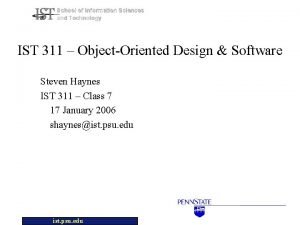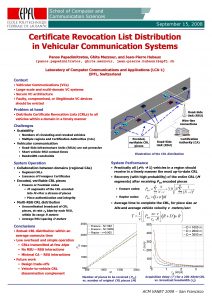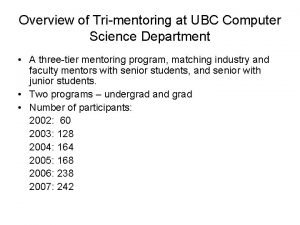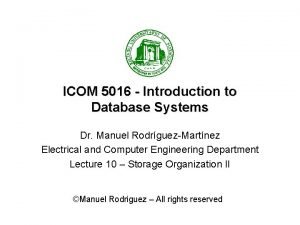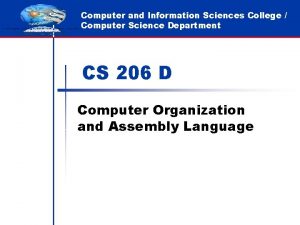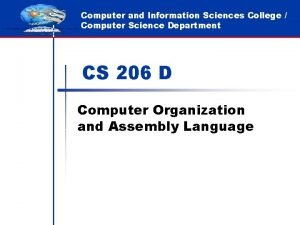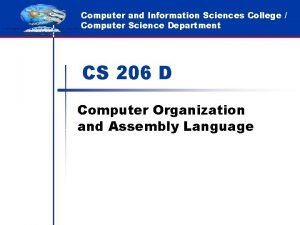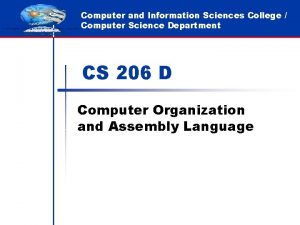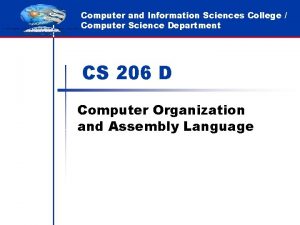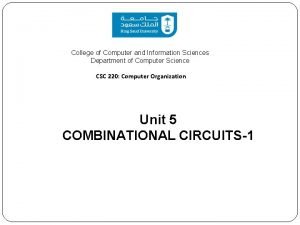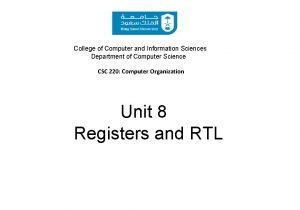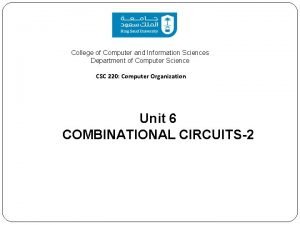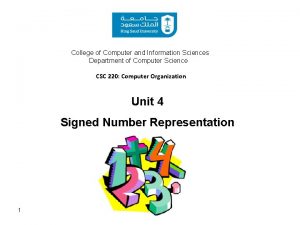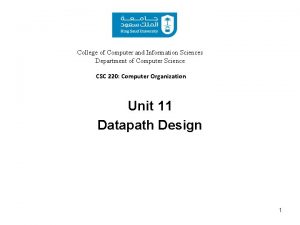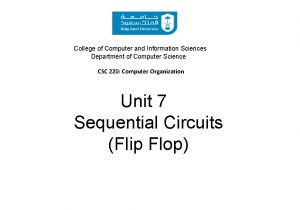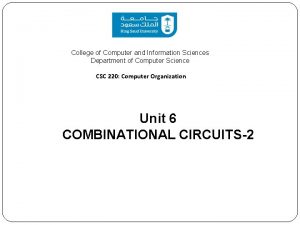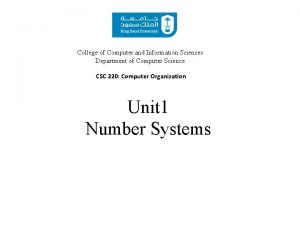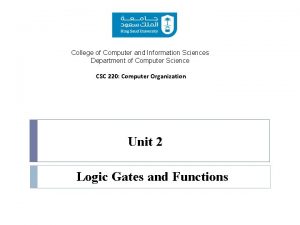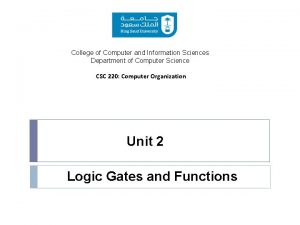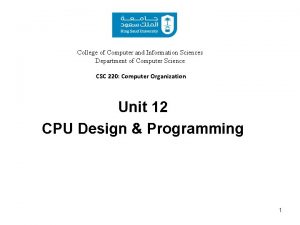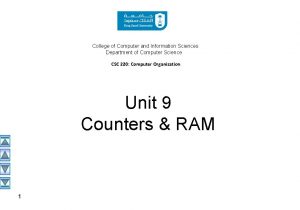College of Computer and Information Sciences Department of


























- Slides: 26

College of Computer and Information Sciences Department of Computer Science CSC 220: Computer Organization Unit 10 Arithmetic-logic Units 1

Unit 10: Arithmetic-logic Units Overview • Arithmetic Unit Design • Primitive gates base implementation • MUX-based implementation • Logic Unit Design • Arithmetic-logic Unit Design Chapter-8 M. Morris Mano, Charles R. Kime and Tom Martin, Logic and Computer Design Fundamentals, Global (5 th) Edition, Pearson Education Limited, 2016. ISBN: 9781292096124

Remember: 3

Arithmetic-logic units • • An arithmetic-logic unit, or ALU, performs many different arithmetic and logic operations. The ALU is the “heart” of a processor—you could say that everything else in the CPU is there to support the ALU. Here’s the plan: – – – • We’ll show an arithmetic unit first, by building off ideas from the adder-subtractor circuit. Then we’ll talk about logic operations a bit, and build a logic unit. Finally, we put these pieces together using multiplexers. We show the same examples as from the book. 4

The four-bit adder • The basic four-bit adder always computes S = A + B + CI. • But by changing what goes into the adder inputs A, B and CI, we can change the adder output S. This is also what we did to build the combined adder-subtractor circuit. • 5

It’s the adder-subtractor again! • Here the signal Sub and some XOR gates alter the adder inputs. – When Sub = 0, the adder inputs A, B, CI are Y, X, 0, so the adder produces G = X + Y + 0, or just X + Y. – When Sub = 1, the adder inputs are Y’, X and 1, so the adder output is G = X + Y’ + 1, or the two’s complement operation X - Y. 6

The multi-talented adder • • • So we have one adder performing two separate functions. “Sub” acts like a function select input which determines whether the circuit performs addition or subtraction. Circuit-wise, all “Sub” does is modify the adder’s inputs A and CI. 7

Modifying the adder inputs • • By following the same approach, we can use an adder to compute other functions as well. We just have to figure out which functions we want, and then put the right circuitry into the “Input Logic” box. 8

Some more possible functions • • We already saw how to set adder inputs A, B and CI to compute either X + Y or X - Y. How can we produce the increment function G = X + 1? One way: Set A = 0000, B = X, and CI = 1 • How about decrement: G = X - 1? A = 1111 (-1), B = X, CI = 0 • How about transfer: G = X? (This can be useful. ) A = 0000, B = X, CI = 0 This is almost the same as the increment function! 9

The role of CI • • • The transfer and increment operations have the same A and B inputs, and differ only in the CI input. In general we can get additional functions (not all of them useful) by using both CI = 0 and CI = 1. Another example: – Two’s-complement subtraction is obtained by setting A = Y’, B = X, and CI = 1, so G = X + Y’ + 1. – If we keep A = Y’ and B = X, but set CI to 0, we get G = X + Y’. This turns out to be a ones’ complement subtraction operation. 10

Table of arithmetic functions • • Here are some of the different possible arithmetic operations. We’ll need some way to specify which function we’re interested in, so we’ve randomly assigned a selection code to each operation. G 11

Mapping the table to an adder • • This second table shows what the adder’s inputs should be for each of our eight desired arithmetic operations. – – – Adder input CI is always the same as selection code bit S 0. B is always set to X. A depends only on S 2 and S 1. These equations depend on both the desired operations and the assignment of selection codes. 12

Building the input logic • • All we need to do is compute the adder input A, given the arithmetic unit input Y and the function select code S (actually just S 2 and S 1). Here is an abbreviated truth table: inputs • output We want to pick one of these four possible values for A, depending on S 2 and S 1. 13

Primitive gate-based input logic • • • We could build this circuit using primitive gates. If we want to use K-maps for simplification, then we should first expand out the abbreviated truth table. – The Y that appears in the output column (A) is actually an input. – We make that explicit in the table on the right. Remember A and Y are each 4 bits long! inputs output 14

Primitive gate implementation • From the truth table, we can find an MSP: A i = S 2 Y i ’ + S 1 Y i • Again, we have to repeat this once for each bit Y 3 -Y 0, connecting to the adder inputs A 3 -A 0. • This completes our arithmetic unit. 15

Multiplexer-based implementation Alternative Implementation using 4 bit adder circuit and multiplexers 16

17

Bitwise operations • • Most computers also support logical operations like AND, OR and NOT, but extended to multi-bit words instead of just single bits. To apply a logical operation to two words X and Y, apply the operation on each pair of bits Xi and Yi: 1 0 1 1 AND 1 1 1 0 1 0 • OR 1 0 1 1 1 1 1 0 1 1 XOR 1 1 1 0 01 01 Single operand logical operation: “complementing” all the bits in a number. NOT 1 0 1 1 01 00 18

Bitwise operations in programming • Languages like C, C++ and Java provide bitwise logical operations: & (AND) • • ~ (NOT) because 01101 & 11001 = 01001 They are not the same as the operators &&, || and !, which treat each integer as a single logical value (0 is false, everything else is true): 13 && 25 = 1 • ^ (XOR) These operations treat each integer as a bunch of individual bits: 13 & 25 = 9 • | (OR) because true && true = true Bitwise operators are often used in programs to set a bunch of Boolean options, or flags, with one argument. Easy to represent sets of fixed universe size with bits: – 1: is member, 0 not a member. Unions: OR, Intersections: AND 19

Defining a logic unit • • A logic unit supports different logical functions on two multi-bit inputs X and Y, producing an output G. This abbreviated table shows four possible functions and assigns a selection code S to each. We’ll just use multiplexers and some primitive gates to implement this. Again, we need one multiplexer for each bit of X and Y. 20

Our simple logic unit • • Inputs: – X (4 bits) – Y (4 bits) – S (2 bits) Outputs: – G (4 bits) 21

Combining the arithmetic and logic units • Now we have two pieces of the puzzle: – An arithmetic unit that can compute eight functions on 4 -bit inputs. – A logic unit that can perform four functions on 4 -bit inputs. • We can combine these together into a single circuit, an arithmetic-logic unit (ALU). 22

Our ALU function table • • This table shows a sample function table for an ALU. All of the arithmetic operations have S 3=0, and all of the logical operations have S 3=1. These are the same functions we saw when we built our arithmetic and logic units a few minutes ago. Since our ALU only has 4 logical operations, we don’t need S 2. The operation done by the logic unit depends only on S 1 and S 0. 23

A complete ALU circuit The / and 4 on a line indicate that it’s actually four lines. 4 Cout should be ignored when logic operations are performed (when S 3=1). 4 4 G is the final ALU output. • When S 3 = 0, the final output comes from the arithmetic unit. • When S 3 = 1, the output comes from the logic unit. The arithmetic and logic units share the select inputs S 1 and S 0, but only the arithmetic unit uses S 2. 24

Comments on the multiplexer • • • Both the arithmetic unit and the logic unit are “active” and produce outputs. – The mux determines whether the final result comes from the arithmetic or logic unit. – The output of the other one is effectively ignored. Our hardware scheme may seem like wasted effort, but it’s not really. – “Deactivating” one or the other wouldn’t save that much time. – We have to build hardware for both units anyway, so we might as well run them together. This is a very common use of multiplexers in logic design. 25

The completed ALU • • This ALU is a good example of hierarchical design. – With the 12 inputs, the truth table would have had 212 = 4096 lines. That’s an awful lot of paper. – Instead, we were able to use components that we’ve seen before to construct the entire circuit from a couple of easy-to-understand components. As always, we encapsulate the complete circuit in a “black box” so we can reuse it in fancier circuits. 4 4 26
 College of information sciences and technology
College of information sciences and technology Natural sciences tok
Natural sciences tok College of humanities and social sciences
College of humanities and social sciences Uf prehealth advising
Uf prehealth advising Usf college of behavioral and community sciences
Usf college of behavioral and community sciences Ghita mezzour
Ghita mezzour Queens high school for the sciences at york college
Queens high school for the sciences at york college عبور2ثبت
عبور2ثبت Site:slidetodoc.com
Site:slidetodoc.com Tum department of electrical and computer engineering
Tum department of electrical and computer engineering Latest electronics and information technology in odisha
Latest electronics and information technology in odisha Pasadena city college police department
Pasadena city college police department Ucl computer science meng
Ucl computer science meng Northwestern electrical engineering
Northwestern electrical engineering Computer science department rutgers
Computer science department rutgers Stanford vptl tutoring
Stanford vptl tutoring Computer science fsu
Computer science fsu Trimentoring
Trimentoring Department of computer science christ
Department of computer science christ Computer engineering department
Computer engineering department Mice.cs.columbia
Mice.cs.columbia Ucf college of engineering and computer science
Ucf college of engineering and computer science Department of information technology
Department of information technology Department of information engineering university of padova
Department of information engineering university of padova Information engineering padova
Information engineering padova Department of the navy chief information officer
Department of the navy chief information officer Department of electronics & information technology
Department of electronics & information technology
